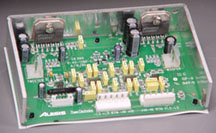This page describes how to use that Revision 3 stereo 3-way board described in a previous article to make very nice sounding speakers using modern tools and a process that many DIY’ers will find interesting and exciting. As should become evident, the designer still needs measurement equipment, good judgement and speaker-designing experience to make highly successful designs, but even the novice will be able to have good results. But for both the experienced designer and the novice, a lot of the drudgery and boring aspects of speaker building have been eliminated with this process, and the process will be much quicker and more interesting.
Background
Does anyone remember those Alesis amp modules sold at Apexjr about 15 years ago? That’s how this WiFi/DSP project got it’s initial start. These modules had two LM3886-series power amps with an 8-pole Linkwitz-Riley crossover. You could “easily” change the crossover frequency by swapping out the capacitors, and with a few more modifications these modules could be connected together to build higher order systems.

I built quite a few 2-way and 3-way speakers with these modules, and even built a 5-way system that I used for many years as my desk system. The really nice thing about using these modules is that you could use just about any decent drivers and the speakers would sound good. That’s because those sharp 8-pole filters were effective at eliminating the break-up regions of mids or woofers, and they provided protection for tweeters to keep them operating in a region where distortion was low. And the steep crossover ensured excellent integration of the woofer and tweeter. So as long as the drivers were reasonably “well behaved” in their intended frequency range, and were properly matched in level, the speakers sounded good. And the many speakers I made with these modules verified that–no matter what the drivers, the results were usually very good and very “usable” without extensive tweaking or “voicing”.
The point of this trip down memory lane isn’t to extol the virtues of active speakers, as there are some articles on this website and many others that describe the benefits of active speakers. The point is to “gently” introduce a somewhat radical approach to a 3-way speaker in which the drivers aren’t specified. You will need drivers, obviously, but for this project we merely provide some general characteristics of each driver, but leave the sizes, series and specific part numbers to the implementer. That’s a different approach to speaker design than what you might find elsewhere, but we’ll show a couple of examples that should demonstrate how well this approach can work.
Another unusual feature of this design is that the amplifiers for the active system aren’t specified, either. There was a time when I was making combination DSP/amplifier boards, and I still like that approach. However, including the amplifiers on the board makes the board design and mechanical design much more difficult, and complicates assembly issues. The hard-core DIY’er might do OK with the high parts count, but too often the combined DSP/amp approach just becomes too tedious for the beginner or those without the soldering tools needed for success. In the last few years there have been lot of high quality amplifier modules available, at very reasonable prices. So for this project the amplifiers will be purchased items that are selected by the project implementer. Again, there are some guidelines for selecting the amplifiers for this project, but the specific modules are left as a choice for the implementer.
Overview
The key to the generic speaker is an updated and much more powerful version of those Alesis modules. Instead of having a fixed crossover like those Alesis modules, we are using a DSP processor that allows selecting a several common loudspeaker crossover types by using a cell phone app. We can change the crossover type, the crossover frequency and order and polarity. And we can also provide overall EQ, baffle step compensation, and extra filters that can be applied to specific drivers.
The DSP board we are using also has bass boost, a rumble filter and even a psychoacoustic bass enhancement algorithm that gives the impression of additional low frequencies by adding correlated harmonics. These DSP tools help the generic 3-way design be less dependent on the cabinet selection, so that in many cases, the implementer can simply buy a knock-down or preassembled cabinet and enjoy good results.
A very important feature of this design is the wireless input. Notice that it is the only input, as there are no other analog or digital inputs…
[Just a batch of ideas here…will finish this off later]
The Process
[steps]
Compare this capability to the conventional speaker design flow. The conventional flow usually starts with driver selection, since the drivers are typically the most costly items in the design. Once the drivers are selected, the cabinet needs to be designed or selected, or at least modeled, as the cabinet defines the system response at the lowest frequencies and also has significant contributions in the lower midrange due to “baffle step” and some impact on upper midrange and treble ranges due to diffraction. The drivers then need to be measured in the selected cabinet, although there are some modeling tools that can be used to predict the response from measurements taken without the cabinets. Once the measurements are available, you can move on to crossover design. The crossover is where the driver levels are matched and where components are selected to achieve the desired crossover slopes. The crossover interacts with the impedance profiles of the drivers, so the crossover ends up being specifically designed for the selected drivers. Crossover design is something of an art, because you need to know how to select slopes that minimize driver distortion, achieve a flat response, and keep the number of components to a reasonable level. It’s a juggling act, but your efforts are only valid for those specific drivers–the crossover is specific to those drivers and that cabinet.